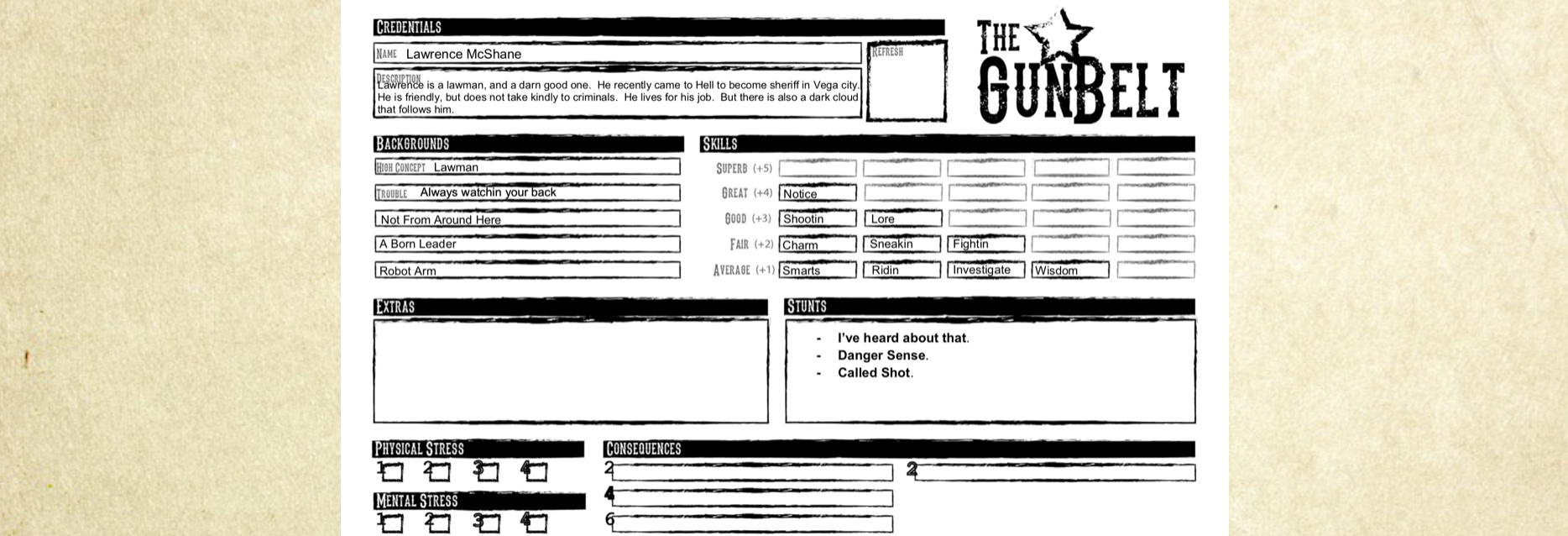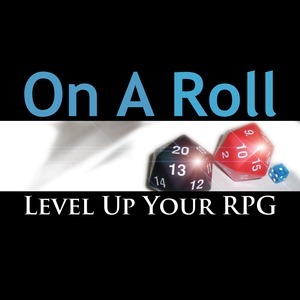Ryan has been developing a tabletop roleplaying game, The Gun Belt for over three years. The game features alien and robot cowboys riding dinosaurs in an interstellar Wild West on a world with no wheels. It is currently in the process of playtesting. This blog explores the process he and his design partner, Ashley, have experienced during that time.

Ashley and I initially settled on using the open game licensed system Fate as the mechanics of choice for The Gun Belt. I was not familiar with it at the onset, but Ashley loves it. I trust him, so we went for it. The great thing about Fate is that it is actually available for free online from the company. They are quite giving when it comes to supplying resources to game designers for free.
The Gun Belt is a harsh world, so the first challenge with Fate that we encountered was that we would need to reign in the narrative nature of it. There’s a lot of collaborative storytelling built into the Fate toolkit that is wonderful, but also not quite the feel we were hoping for. Ashley felt like this was something we could handle, and some additional research into existing Fate games seemed to prove that was the case.
One of the things we loved about Fate was that it incorporates the character’s history and place in the world into character creation. This was an idea that I felt strongly about. I love the way character creation does this in Masks, and finding a similar relationship between creation and history in Fate was a big win for me. We were particularly attracted to using the High Concept functionality with the Troubles rules, as these work well in genres like Wild West in which tropes are prominent and important.
In Fate, the basic mechanics are centered around Aspects, Skills and Stunts. As we skinned the Fate system to work for our interstellar wild west setting, we looked at several different Fate games for inspiration, focusing on games that had very specific and nuanced worlds. These included Blood on the Trails (a wild west vampire game), Dresden Files, Atomic Robo and the Fate Worlds Volume 1 book. As we progressed, Aspects became named Backgrounds, we established the Skills we would use and we created a considerable variety of Stunts that took great advantage of the tropes of the genres we were utilizing. Ashley created a mock up character sheet and a few characters and we set to work doing some short, mock dice-rolling sessions to see how things worked.
One example of our Fate Stunt work was the Ride Skill:
–––––––––––––––––––
Ride
The Ride skill covers the ability to break, train and climb on the back of hellbenders to use as beasts of burden for work or travel. Ride represents how well a familiar creature (your mount) will listen to you, do what you ask and come when you call, as well as your ability to stay on its back when it’s running across the plains at top speed. Frightening an animal away would be Intimidate and judging if an animal was friendly or not would be Empathy.
Overcome: Ride is the equivalent of Athletics when you’re on the back of a hellbender. Use it to do difficult things or to do normal things under difficult circumstances, like moving through rough terrain, squeezing through small spaces, jumping chasms and so forth.
**Create an Advantage: **You might use Ride to put some distance between yourself and a pursuer, get some extra speed from your hellbender or declare that you know a Convenient Shortcut or something similar.
Attack: You can use Ride to have your hellbender bite another hellbender or .
**Defend: **You’ll use Ride to defend against most attacks made against you while you’re on the back of a hellbender; you can also use it to defend when your mount is under attack.
Ride Stunts **
**Animal Ken: You can use Ride as if it were Empathy when you’re communicating with domesticated animals; you can also use it as if it were Charm, but you can only communicate basic ideas and simple directions. If you spend a fate point, you can use this stunt on wild animals for the rest of the scene.
**Ride Like the Wind: **You have the Upper Hand when using Ride to create speed-based advantages.
**The Whistle: **You can spend a fate point and whistle for your hellbender, and she’ll show up within a few exchanges. It has to be your animal, a hellbender you’ve owned for a while and created a bond with. Your hellbender’s arrival can be improbable, but if the GM deems it impossible that she’d be there, you get your fate point back.
Special Aspect
A Little Birdie: You may only take this stunt if you are part of the Birdie culture. You may use Ride to pilot a raptor, replacing “hellbender” with “raptor” in the Ride skill and stunts. This is a trade off, as you may not use Ride to mount a hellbender, and the Animal Ken stunt may not be used on hellbenders (see Birdies).
–––––––––––––––––––
You can see, it’s actually a lot of work to create these Skill and Stunt sets. With 21 Skills, each offering three Stunts and specific “special” Aspects, we began to feel like this was becoming a daunting task. Moreover, they have to all be somewhat balanced against one another. Concerned we were growing overwhelmed, we decided to explore another system we both were familiar with.
The old Star Wars WEG mechanics have evolved into an OGL system known as D6. The D6 system is straightforward (it’s a basic Attribute/Skill dice pool system with target numbers), and it was simple enough that we thought we could easily adapt it to our needs.
The transition to the D6 system was rather easy. The system worked fine for The Gun Belt, with very little alteration required, but it came with costs. The first is that there are six Attributes, which was more than we were wanting. The second was that the way the system is designed, your game’s Skill list needs to be quite drilled down into really specific areas. By the time we finished transitioning into the D6 system, our Skill list had went from 21 to nearly 50.
We realized that we were trading more complicated rules and simple skills for simple rules and more complicated skills. It wasn’t a trade we were interested in making.
Frustrated but also inspired, Ashley noted that we had learned a huge amount about different systems in our initial research and in our experiments with Fate and D6. We sat down and made a list of the things, rules and system quirks we had seen in games that we liked. Then we made a list of the things, rules and system quirks we didn’t like. With little hesitance, Ashley smiled and said, “Let’s just build our own thing that uses this ‘like’ list and doesn’t use this ‘dislike’ list.”
That’s when the Part and Parcel system was born.
